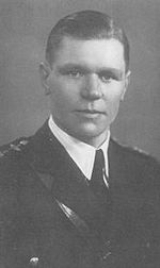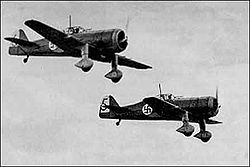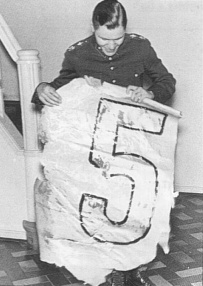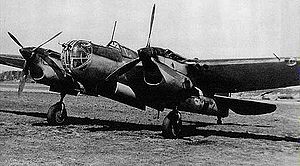
Jorma Sarvanto
Encyclopedia
Jorma Kalevi Sarvanto was a Finnish
Air Force
pilot and the foremost Finnish fighter ace of the Winter War
.
. He decided to apply to the Cadet School, Air Warfare Section where he wanted to become a cadre (professional) officer, and he was admitted in autumn 1934. In May 1937 his training was completed.
Sarvanto was at first sent to Lentoasema 1 (Air Base One) at Utti and later to Lentorykmentti 4 (Flight Regiment 4), which was a bomber squadron. He had wished to fly fighters and requested a transfer to Fighter Squadron 24, which was granted. He started to fly Fokker D.XXIs there in 1937. He excelled in the firing tests, with a hit average of 92%.


 On November 30, 1939, the Winter War
On November 30, 1939, the Winter War
erupted and Finland was at war with the Soviet Union
. He saw his first battle on December 19, and his first two victories came on December 23, 1939.
On January 6, 1940, lieutenant Per-Erik Sovelius encountered 8 Ilyushin DB-3
s while being on patrol. He immediately downed one of them. The rest continued towards the north. He radioed their position to the Utti Air Force Base where Sarvanto was based. The alarm sounded and Sarvanto and other pilots ran out to their Fokker D.XXI
s and lifted off. Sarvanto was the first one off the ground and he could see the aircraft far away in the clear sky.
Closing in on the aircraft, 300 meters (1,000 ft) behind, the bombers opened fire. His plane vibrated from some hits. He continued onwards and being only 20 meters (70 ft) away from the bombers he opened fire with his machine guns and silenced the machine gunners of two aircraft. Then he aimed for the engines and fired very short bursts. Flames ignited and smoke trailed after the aircraft, soon the two first aircraft started to go down.
Cheering his kills he saw that another bomber had separated from the group. This one too was soon dealt with. Sarvanto now set his goal on destroying every single one of the bombers. The bombers maneuvered wildly, trying to shake him, but to no avail. One by one they went down with a thick black plume of smoke trailing the aircraft. There was only one bomber left. Sarvanto aligned himself behind the aircraft and aimed carefully. But when he pulled the trigger, his machine guns were silent. He was out of ammunition. He had no other option but to break off and go home. On the ground he would see the smoke, where the bombers had gone down.
Sarvanto had managed to down six bombers during a mission that lasted about 25 minutes. The fight itself took no longer than 4–5 minutes. There were two witnesses to the air battle, lieutenant Sovelius and lieutenant Ikonen. They took up the chase for the last bomber and Sovelius managed to down the bomber near the island of Hogland
in the Gulf of Finland
. Afterwards it was calculated that Sarvanto had not used more than about 400 shots against each bomber, some of these to silence the machine gunners.
When Sarvanto landed and he and his ground crew started to investigate the damage on his aircraft, they found 23 bullet holes in the fuselage, some very close to the cockpit.
This incident drew a lot of attention worldwide, and the press considered it a world record. Most of the major Western newspapers published a photo of lieutenant Sarvanto holding a large sheet of aluminum with a big "5" on it, a trophy from one of the victims.
Sarvanto was to become the top scoring Finnish ace of the Winter War with 13 victories. During the Continuation War
he downed four more aircraft with Brewster Buffalo
es, bringing his total score to 17. He flew a total of 255 combat missions during WWII.
In 1941 he was appointed captain and he was given different staff positions, e.g. as a liaison officer with the German Luftflotte 1, as the commander of LeLv 24's 2nd division and later as the commander of TLeLv 35.
in London, a position he held for 3½ years before returning to his position at the Flight School. Sarvanto resigned from the air force in 1960, with the rank of lieutenant colonel.
Sarvanto had married before the war and had four children. He would work as the CEO of a bank until his death on October 16, 1963.
Sarvanto's grandsons include American
champion bagpipe player
Jori Chisholm
and American political consultant Kari Chisholm
.

Finland
Finland , officially the Republic of Finland, is a Nordic country situated in the Fennoscandian region of Northern Europe. It is bordered by Sweden in the west, Norway in the north and Russia in the east, while Estonia lies to its south across the Gulf of Finland.Around 5.4 million people reside...
Air Force
Finnish Air Force
The Finnish Air Force is one of the branches of the Finnish Defence Forces. Its peacetime tasks are airspace surveillance, identification flights, and production of readiness formations for wartime conditions...
pilot and the foremost Finnish fighter ace of the Winter War
Winter War
The Winter War was a military conflict between the Soviet Union and Finland. It began with a Soviet offensive on 30 November 1939 – three months after the start of World War II and the Soviet invasion of Poland – and ended on 13 March 1940 with the Moscow Peace Treaty...
.
Early life
Sarvanto was born and raised in Turku, Finland. He attended high school in Turku and graduated in 1933. He was first admitted to the Pori Infantry Regiment, but decided to apply when the Finnish Air Force sent out a notice that they would select officer trainees. He was admitted and sent to the Reserve Officer Pilot Course number 4 at the Kauhava Air Base. He knew he had come to the right place. He completed his reserve officer training in 1934 and was unemployed for a while due to the Great DepressionGreat Depression
The Great Depression was a severe worldwide economic depression in the decade preceding World War II. The timing of the Great Depression varied across nations, but in most countries it started in about 1929 and lasted until the late 1930s or early 1940s...
. He decided to apply to the Cadet School, Air Warfare Section where he wanted to become a cadre (professional) officer, and he was admitted in autumn 1934. In May 1937 his training was completed.
Sarvanto was at first sent to Lentoasema 1 (Air Base One) at Utti and later to Lentorykmentti 4 (Flight Regiment 4), which was a bomber squadron. He had wished to fly fighters and requested a transfer to Fighter Squadron 24, which was granted. He started to fly Fokker D.XXIs there in 1937. He excelled in the firing tests, with a hit average of 92%.
War service



Winter War
The Winter War was a military conflict between the Soviet Union and Finland. It began with a Soviet offensive on 30 November 1939 – three months after the start of World War II and the Soviet invasion of Poland – and ended on 13 March 1940 with the Moscow Peace Treaty...
erupted and Finland was at war with the Soviet Union
Soviet Union
The Soviet Union , officially the Union of Soviet Socialist Republics , was a constitutionally socialist state that existed in Eurasia between 1922 and 1991....
. He saw his first battle on December 19, and his first two victories came on December 23, 1939.
On January 6, 1940, lieutenant Per-Erik Sovelius encountered 8 Ilyushin DB-3
Ilyushin DB-3
The Ilyushin DB-3 was a Soviet bomber aircraft of World War II. It was a twin-engined, low-wing monoplane that first flew in 1935. It was the precursor of the Ilyushin Il-4...
s while being on patrol. He immediately downed one of them. The rest continued towards the north. He radioed their position to the Utti Air Force Base where Sarvanto was based. The alarm sounded and Sarvanto and other pilots ran out to their Fokker D.XXI
Fokker D.XXI
-See also:-References:NotesBibliography* De Jong, Peter. Le Fokker D.21 . Outreau, France: Éditions Lela Presse, 2005. ISBN 2-914017-26-X....
s and lifted off. Sarvanto was the first one off the ground and he could see the aircraft far away in the clear sky.
Closing in on the aircraft, 300 meters (1,000 ft) behind, the bombers opened fire. His plane vibrated from some hits. He continued onwards and being only 20 meters (70 ft) away from the bombers he opened fire with his machine guns and silenced the machine gunners of two aircraft. Then he aimed for the engines and fired very short bursts. Flames ignited and smoke trailed after the aircraft, soon the two first aircraft started to go down.
Cheering his kills he saw that another bomber had separated from the group. This one too was soon dealt with. Sarvanto now set his goal on destroying every single one of the bombers. The bombers maneuvered wildly, trying to shake him, but to no avail. One by one they went down with a thick black plume of smoke trailing the aircraft. There was only one bomber left. Sarvanto aligned himself behind the aircraft and aimed carefully. But when he pulled the trigger, his machine guns were silent. He was out of ammunition. He had no other option but to break off and go home. On the ground he would see the smoke, where the bombers had gone down.
Sarvanto had managed to down six bombers during a mission that lasted about 25 minutes. The fight itself took no longer than 4–5 minutes. There were two witnesses to the air battle, lieutenant Sovelius and lieutenant Ikonen. They took up the chase for the last bomber and Sovelius managed to down the bomber near the island of Hogland
Hogland
Gogland or Hogland is an island in the Gulf of Finland of the Baltic Sea, located some 180 km west of Saint Petersburg and 35 km away from the coast of Finland . The island is a part of the Leningrad Oblast, Russia. The area of Hogland Island is approximately...
in the Gulf of Finland
Gulf of Finland
The Gulf of Finland is the easternmost arm of the Baltic Sea. It extends between Finland and Estonia all the way to Saint Petersburg in Russia, where the river Neva drains into it. Other major cities around the gulf include Helsinki and Tallinn...
. Afterwards it was calculated that Sarvanto had not used more than about 400 shots against each bomber, some of these to silence the machine gunners.
When Sarvanto landed and he and his ground crew started to investigate the damage on his aircraft, they found 23 bullet holes in the fuselage, some very close to the cockpit.
This incident drew a lot of attention worldwide, and the press considered it a world record. Most of the major Western newspapers published a photo of lieutenant Sarvanto holding a large sheet of aluminum with a big "5" on it, a trophy from one of the victims.
Sarvanto was to become the top scoring Finnish ace of the Winter War with 13 victories. During the Continuation War
Continuation War
The Continuation War was the second of two wars fought between Finland and the Soviet Union during World War II.At the time of the war, the Finnish side used the name to make clear its perceived relationship to the preceding Winter War...
he downed four more aircraft with Brewster Buffalo
Brewster Buffalo
The Brewster F2A Buffalo was an American fighter aircraft which saw limited service early in World War II. Though the Buffalo won a competition against the Grumman F4F Wildcat in 1939 to become the US Navy's first monoplane fighter aircraft, it turned out to be a big disappointment...
es, bringing his total score to 17. He flew a total of 255 combat missions during WWII.
In 1941 he was appointed captain and he was given different staff positions, e.g. as a liaison officer with the German Luftflotte 1, as the commander of LeLv 24's 2nd division and later as the commander of TLeLv 35.
After the war
Sarvanto would continue his military career, which led him to become the commander of the Flight School in Kauhava. In 1954, he became Finnish military attachéMilitary attaché
A military attaché is a military expert who is attached to a diplomatic mission . This post is normally filled by a high-ranking military officer who retains the commission while serving in an embassy...
in London, a position he held for 3½ years before returning to his position at the Flight School. Sarvanto resigned from the air force in 1960, with the rank of lieutenant colonel.
Sarvanto had married before the war and had four children. He would work as the CEO of a bank until his death on October 16, 1963.
Sarvanto's grandsons include American
United States
The United States of America is a federal constitutional republic comprising fifty states and a federal district...
champion bagpipe player
Bagpipes
Bagpipes are a class of musical instrument, aerophones, using enclosed reeds fed from a constant reservoir of air in the form of a bag. Though the Scottish Great Highland Bagpipe and Irish uilleann pipes have the greatest international visibility, bagpipes of many different types come from...
Jori Chisholm
Jori Chisholm
Jori Lance Chisholm is an American professional bagpipe player and teacher who lives in Seattle, Washington. He has played with the six-time Grade One World Champion Simon Fraser University Pipe Band since 1998 and has been a featured solo performer for the band on multiple occasions...
and American political consultant Kari Chisholm
Kari Chisholm
Kari Chisholm is a Democratic political consultant and a prominent commentator on Oregon politics and the Heisman Trophy.-Political consultant:...
.
Aerial victories

| Number | Date | Place | Own aircraft | Enemy aircraft | Enemy regiment |
|---|---|---|---|---|---|
| 1 | Dec 23, 1939 | Noskuanselkä | FR-97 | SB Tupolev SB The Tupolev ANT-40, also known by its service name Tupolev SB , and development co-name TsAGI-40, was a high speed twin-engined three-seat monoplane bomber, first flown in 1934.... |
44.SBAP |
| 2 | Dec 23, 1939 | Noisniemi | FR-97 | SB Tupolev SB The Tupolev ANT-40, also known by its service name Tupolev SB , and development co-name TsAGI-40, was a high speed twin-engined three-seat monoplane bomber, first flown in 1934.... |
44.SBAP |
| 3 | Jan 6, 1940 | Utti-Tavastila | FR-97 | DB-3 Ilyushin DB-3 The Ilyushin DB-3 was a Soviet bomber aircraft of World War II. It was a twin-engined, low-wing monoplane that first flew in 1935. It was the precursor of the Ilyushin Il-4... |
6.DBAP |
| 4 | Jan 6, 1940 | Utti-Tavastila | FR-97 | DB-3 Ilyushin DB-3 The Ilyushin DB-3 was a Soviet bomber aircraft of World War II. It was a twin-engined, low-wing monoplane that first flew in 1935. It was the precursor of the Ilyushin Il-4... |
6.DBAP |
| 5 | Jan 6, 1940 | Utti-Tavastila | FR-97 | DB-3 Ilyushin DB-3 The Ilyushin DB-3 was a Soviet bomber aircraft of World War II. It was a twin-engined, low-wing monoplane that first flew in 1935. It was the precursor of the Ilyushin Il-4... |
6.DBAP |
| 6 | Jan 6, 1940 | Utti-Tavastila | FR-97 | DB-3 Ilyushin DB-3 The Ilyushin DB-3 was a Soviet bomber aircraft of World War II. It was a twin-engined, low-wing monoplane that first flew in 1935. It was the precursor of the Ilyushin Il-4... |
6.DBAP |
| 7 | Jan 6, 1940 | Utti-Tavastila | FR-97 | DB-3 Ilyushin DB-3 The Ilyushin DB-3 was a Soviet bomber aircraft of World War II. It was a twin-engined, low-wing monoplane that first flew in 1935. It was the precursor of the Ilyushin Il-4... |
6.DBAP |
| 8 | Jan 6, 1940 | Utti-Tavastila | FR-97 | DB-3 Ilyushin DB-3 The Ilyushin DB-3 was a Soviet bomber aircraft of World War II. It was a twin-engined, low-wing monoplane that first flew in 1935. It was the precursor of the Ilyushin Il-4... |
6.DBAP |
| 9 | Jan 17, 1940 | Heinjoki | FR-99 | SB Tupolev SB The Tupolev ANT-40, also known by its service name Tupolev SB , and development co-name TsAGI-40, was a high speed twin-engined three-seat monoplane bomber, first flown in 1934.... |
54.SBAP |
| 10 | Feb 3, 1940 | Nuijamaa | FR-80 | DB-3 Ilyushin DB-3 The Ilyushin DB-3 was a Soviet bomber aircraft of World War II. It was a twin-engined, low-wing monoplane that first flew in 1935. It was the precursor of the Ilyushin Il-4... |
42.DBAP |
| 11 | Feb 15, 1940 | Vyborg | FR-80 | DB-3 Ilyushin DB-3 The Ilyushin DB-3 was a Soviet bomber aircraft of World War II. It was a twin-engined, low-wing monoplane that first flew in 1935. It was the precursor of the Ilyushin Il-4... |
42.DBAP |
| 12 | Feb 18, 1940 | Simola | FR-100 | DB-3 Ilyushin DB-3 The Ilyushin DB-3 was a Soviet bomber aircraft of World War II. It was a twin-engined, low-wing monoplane that first flew in 1935. It was the precursor of the Ilyushin Il-4... |
1.AP KPF |
| 13 | Feb 19, 1940 | Vyborg | FR-100 | DB-3 Ilyushin DB-3 The Ilyushin DB-3 was a Soviet bomber aircraft of World War II. It was a twin-engined, low-wing monoplane that first flew in 1935. It was the precursor of the Ilyushin Il-4... |
21.DBAP |
| 14 | Jun 25, 1941 | Utti | BW-357 | SB Tupolev SB The Tupolev ANT-40, also known by its service name Tupolev SB , and development co-name TsAGI-40, was a high speed twin-engined three-seat monoplane bomber, first flown in 1934.... |
201.SBAP |
| 15 | Jun 29, 1941 | Utti | BW-357 | Pe-2 Petlyakov Pe-2 The Petlyakov Pe-2 was a Soviet dive bomber aircraft used during World War II. It was regarded as one of the best ground attack aircraft of the war and it was extremely successful in the roles of heavy fighter, reconnaissance and night fighter... |
58.SBAP |
| 16 | Apr 21, 1943 | Gulf of Finland | BW-373 | La-5 Lavochkin La-5 |- See also :- References :NotesBibliography* Abanshin, Michael E. and Nina Gut. Fighting Lavochkin, Eagles of the East No.1. Lynnwood, WA: Aviation International, 1993. ISBN unknown.... |
4.GIAP KBF |
| 17 | May 9, 1943 | Gulf of Finland | BW-357 | Yak-7 Yakovlev Yak-7 The Soviet Yakovlev Yak-7 was developed from the earlier Yak-1 fighter, initially as a trainer but converted into a "heavy" fighter. As both a fighter and later reverting to its original training role, the Yak-7 proved to be a capable aircraft and was well liked by air crews. The Yak-7 was simpler,... |
? |
Honors
- Cross of Liberty, 2nd Class, with swords, of the Order of the Cross of LibertyOrder of the Cross of LibertyThere are three official orders in Finland: the Order of the Cross of Liberty , the Order of the White Rose of Finland and the Order of the Lion of Finland. The President of Finland is the Grand Master of the two orders, and usually of the Order of the Cross of Liberty as well, Grand Mastership of...
- Cross of Liberty, 3rd Class, with swords, of the Order of the Cross of LibertyOrder of the Cross of LibertyThere are three official orders in Finland: the Order of the Cross of Liberty , the Order of the White Rose of Finland and the Order of the Lion of Finland. The President of Finland is the Grand Master of the two orders, and usually of the Order of the Cross of Liberty as well, Grand Mastership of...
- Commander of the Order of the White Rose of FinlandOrder of the White RoseThe Order of the White Rose of Finland is one of three official orders in Finland, along with the Order of the Cross of Liberty, and the Order of the Lion of Finland. The President of Finland is the Grand Master of all three orders. The orders are administered by boards consisting of a chancellor,...
- Order of the German Eagle 3rd Class, with swordsOrder of the German EagleThe Order of the German Eagle was an award of the German Nazi regime, predominantly to foreign diplomats. The Order was instituted on 1 May 1937 by Adolf Hitler.It ceased to be awarded following the collapse of the Nazi Government at the end of World War II....
- Luftwaffe's pilot badge honoris causa

